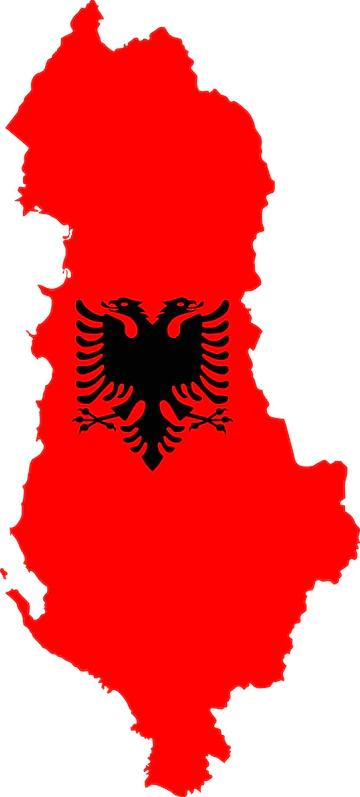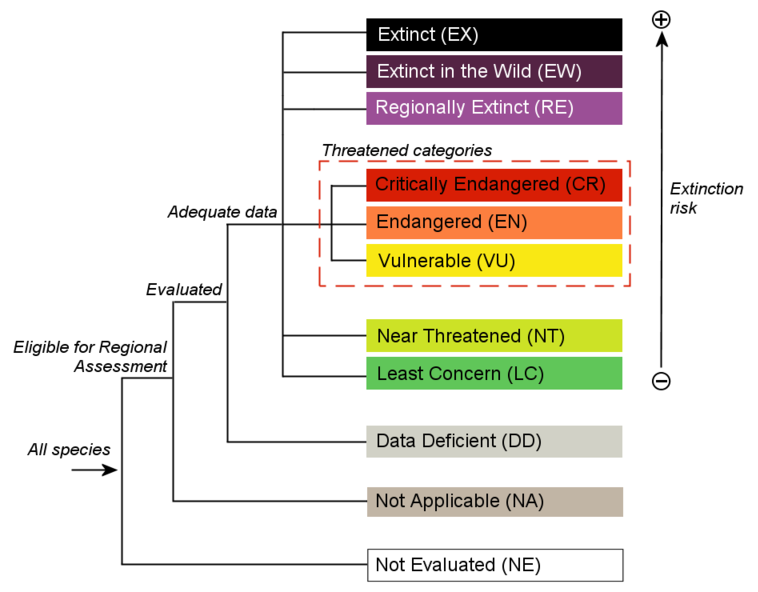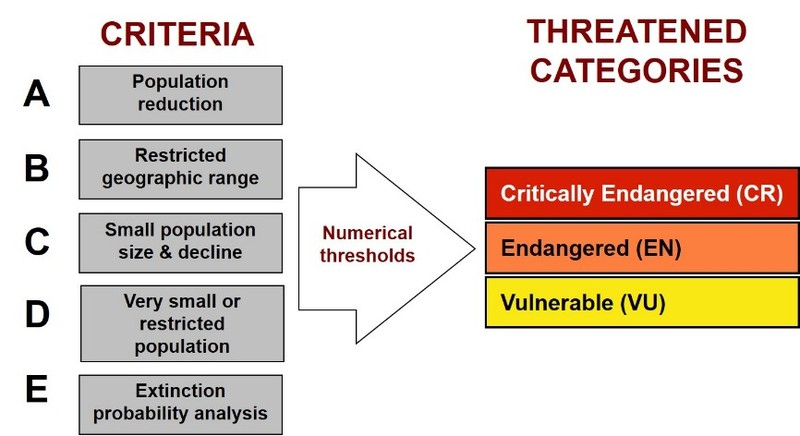11. Red List & the status of the Albanian butterflies in a broader European perspective
The IUCN Red List of Threatened Species, established in 1964, is a checklist of taxa that have undergone a risk assessment process using the IUCN Red List categories and criteria.
The list is a system for classifying species at high risk to becoming extinct and is a valuable indicator of the health of the world’s biodiversity and a tool for protecting natural resources.
Assessing species status based on IUCN criteria at national level is also crucial. (url)
The Butterfly Red List for Albania 2022.
Papilionidae |
Status
Albania
Red List (2022) |
Status
Mediterranean
Red List
(2016) |
Status
European
Red List
(2010) |
Hab. Directives
Annex II, IV
Bern Conv. 2 Cites II
|
Declining
Disjunct
N or S limit |
Papilioninae |
|
|
|
|
|
| 1. Iphiclides podalirius (Linnaeus, 1758) |
LC |
LC |
LC |
|
|
2. Papilio alexanor Esper, [1800]
|
VU B2b |
LC |
LC |
HD IV; B 2 |
* |
| 3. Papilio machaon (Linneaus, 1758) |
LC |
LC |
LC |
|
|
| Parnassiinae |
|
|
|
|
|
| Parnassius apollo (Linnaeus, 1758) |
NT |
LC |
NT A2c |
HD IV; B 2; C II |
* |
| 5. Driopa mnemosyne (Linnaeus, 1758) |
NT |
LC |
NT A2c |
HD IV; B 2 |
* |
| 6. Allancastria cerisyi (Godart, 1823) |
NT |
LC |
NT A2c |
|
* |
| 7. Zerynthia polyxena ([Denis & Schiffermüller], 1775) |
VU B2a |
LC |
LC |
HD IV; B 2 |
* |
| |
|
|
|
|
|
Hesperiiidae |
|
|
|
|
|
Hesperiinae |
|
|
|
|
| 8. Gegenes nostrodamus (Fabricius, 1793) |
NT |
LC |
LC |
|
* |
9. Gegenes pumilio (Hoffman[n]segg, 1804)
|
NT |
LC |
LC |
|
* |
| 10. Pelopidas thrax (Hübner, [1821]) |
|
|
|
|
|
| 11. Hesperia comma (Linneaus, 1758) |
NE |
LC |
LC |
|
* |
| Ochlodes sylvanus (Esper, 1777) |
NE |
LC |
LC |
|
|
| 13. Thymelicus acteon (Rottemburg, 1775) |
NT |
LC |
NT A2b |
|
* |
| 14. Thymelicus lineola (Ochsenheimer, 1808) |
NE |
LC |
LC |
|
* |
| 15. Thymelicus sylvestris (Poda, 1761) |
NE |
LC |
LC |
|
* |
Heteropterinae |
|
|
|
| 16. Carterocephalus palaemon (Pallas, 1771) |
NE |
NA |
LC |
|
* |
17. Heteropterus morpheus (Pallas, 1771)
|
|
| Pyrginae |
|
|
|
|
|
| Carcharodus alceae (Esper, [1780]) |
LC |
LC |
LC |
|
|
| 19. Muschampia floccifera (Zeller, 1847) |
VU |
LC |
NT A2c |
|
|
| 20. Muschampia lavatherae (Esper, [1783]) |
VU |
LC |
NT A2c |
|
* |
| 21. Muschampia orientalis (Reverdin, 1913) |
NE |
LC |
LC |
|
|
| 22. Erynnis marloyi (Boisduval, [1834]) |
VU |
LC |
LC |
|
* |
23. Erynnis tages (Linnaeus, 1758)
|
LC |
LC |
LC |
|
|
| 24. Muschampia alta (Schwingenschuss, 1942) |
NE |
LC (as M. proto) |
LC (as M. proto) |
|
* |
| 25. Muschampia tessellum (Hübner, [1803]) |
DD |
LC |
LC |
|
* |
| 26. Pyrgus alveus (Hübner, [1803]) |
NE |
LC |
LC |
|
* |
| 27. Pyrgus andromedae (Wallengren, 1853) |
NE |
(not included) |
LC |
|
* |
| 28. Pyrgus armoricanus (Oberthür, 1910) |
LC |
LC |
LC |
|
|
| 29. Pyrgus carthami (Hübner, [1813]) |
NE |
LC |
LC |
|
* |
30. Pyrgus cinarae (Rambur, [1839])
|
NE |
LC |
LC |
|
|
| 31. Pyrgus malvae (Linneaus, 1758) |
NE |
LC |
LC |
|
* |
| Pyrgus serratulae (Rambur, [1839]) |
NE |
LC |
LC |
|
* |
| 33. Pyrgus sidae (Esper, [1784]) |
LRnt |
LC |
LC |
|
* |
| 34. Spialia orbifer (Hübner, [1823]) |
NE |
LC |
LC |
|
|
| 35. Spialia phlomidis (Herrich-Schäffer, [1845]) |
NE |
LC |
LC |
|
* |
| |
|
|
|
|
|
| Pieridae |
|
|
|
|
Coliadinae |
|
|
|
|
|
| 36. Colias alfacariensis Ribbe, 1905 |
LC |
LC |
LC |
|
|
| 37. Colias aurorina Herrich-Schäffer, [1850] |
NT |
LC |
LC |
|
* |
| 38. Colias caucasica Staudinger, 1871 |
EN |
EN B12ab (iii, iv) |
LC |
|
* |
| 39. Colias
croceus (Geoffrey, 1785) |
NE |
LC |
LC |
|
|
| 40. Gonepteryx cleopatra (Linnaeus, 1767) |
NT |
LC |
LC |
|
* |
| 41. Gonepteryx farinosa (Zeller, 1847) |
NT |
LC |
LC |
|
* |
| 42. Gonepteryx rhamni (Linnaeus, 1758) |
NE |
LC |
LC |
|
|
Dismorphiinae |
|
|
|
|
|
43. Leptidea duponcheli (Staudinger, 1871) |
VU B1 |
LC |
LC |
|
* |
| 44. Leptidea juvernica Williams, 1946 |
DD |
LC |
LC (as L. reali) |
|
* |
| 45. Leptidea sinapis (Linnaeus, 1758) |
NE |
LC |
LC |
|
|
Pierinae |
|
|
|
|
|
| 46. Anthocharis cardamines (Linnaeus, 1758) |
NE |
LC |
LC |
|
|
| 47. Anthocharis damone Boisduval, 1836 |
NT |
LC |
LC |
|
* |
| 48. Anthocharis gruneri Herrich-Schäffer, [1851] |
NT |
LC |
LC |
|
* |
| 49. Aporia crataegi (Linnaeus, 1758) |
NE |
LC |
LC |
|
* |
| 50. Euchloe ausonia (Hübner, [1804]) |
NE |
LC |
LC |
|
|
| 51. Euchloe penia (Freyer, [1851]) |
VU |
LC |
LC |
|
* |
| 52. Pieris balcana Lorković, [1969] |
LC |
(not included) |
LC |
|
|
| 53. Pieris brassicae (Linnaeus, 1758) |
NE |
LC |
LC |
|
|
| 54. Pieris ergane (Geyer, [1828]) |
NE |
LC |
LC |
|
* |
| 55. Pieris krueperi Staudinger, 1860 |
VU |
LC |
LC |
|
* |
| 56. Pieris mannii (Mayer, 1851) |
NE |
LC |
LC |
|
|
| 57. Pieris napi (Linnaeus, 1758) |
NE |
LC |
LC |
|
|
| 58. Pieris rapae (Linnaues, 1758) |
NE |
LC |
LC |
|
|
| 59. Pontia chloridice (Hübner, [1813]) |
DD |
LC |
LC |
|
* |
| 60. Pontia edusa (Fabricius, 1777) |
NE |
LC |
LC |
|
|
| |
|
|
|
|
|
| Lycaenidae |
|
|
|
|
Lycaeninae |
|
|
|
|
|
| 61. Lycaena alciphron (Rottemburg, 1775) |
NE |
LC |
LC |
|
* |
| 62. Lycaena candens (Herrich-Schäffer, [1844]) |
VU |
(not included) |
LC |
|
|
| 63. Lycaena dispar ([Haworth], 1802) |
VU |
NA |
LC |
HD II, IV; B 2 |
* |
| 64. Lycaena ottomanus (Lefèbvre, 1831) |
VU B2a |
LC |
LC |
|
* |
| 65. Lycaena phlaeas (Linnaeus, 1761) |
NE |
LC |
LC |
|
|
| 66. Lycaena thersamon (Esper, [1784]) |
NE |
LC |
LC |
|
|
| 67. Lycaena tityrus (Poda, 1761) |
NE |
LC |
LC |
|
|
| 68. Lycaena virgaureae (Linnaeus, 1758) |
NE |
LC |
LC |
|
* |
Polyommatinae |
|
|
|
|
|
| 69. Agriades dardanus (Freyer, 1843) |
|
NA |
NT B1a |
|
* |
| 70. Aricia agestis ([Denis & Schiffermüller], 1775) |
NE |
LC |
LC |
|
|
| 71. Aricia anteros (Freyer, 1839) |
LC |
LC |
NT A2c |
|
|
| 72. Aricia artaxerxes (Fabricius, 1793) |
NE |
LC |
LC |
|
* |
| 73. Cacyreus marshalli Butler 1898 |
NE |
NA |
NA |
|
|
| 74. Celastrina argiolus (Linnaeus, 1758) |
NE |
LC |
LC |
|
|
| 75. Cupido alcetas (Hoffman[nsegg, 1804) |
NE |
LC |
LC |
|
* |
| 76. Cupido argiades (Pallas, 1771) |
NE |
LC |
LC |
|
* |
| 77. Cupido decolorata (Staudinger, 1886) |
DD |
LC |
NT A2c |
|
|
| 78. Cupido minimus (Fuessly, 1775) |
LC |
LC |
LC |
|
|
| 79. Cupido osiris (Meigen, 1829) |
VU B2a |
LC |
LC |
|
|
| 80. Cyaniris semiargus (Rottemburg, 1775) |
NE |
LC |
LC |
|
* |
| 81. Eumedonia eumedon (Esper, [1780]) |
NE |
LC |
LC |
|
* |
| 82. Glaucospyche alexis (Poda, 1761) |
VU |
LC |
LC |
|
* |
| 83. Iolana iolas (Ochsenheimer, 1816) |
VU |
LC |
NT A2c |
|
* |
| 84. Kretania sephirus (Frivaldszky, 1835) |
NE |
LC (as P. pylaon) |
LC |
|
* |
| 85. Lampides boeticus (Linnaeus, 1767) |
NE |
LC |
LC |
|
|
| 86. Leptotes pirithous (Linnaeus, 1767) |
LC |
LC |
LC |
|
|
| 87. Lysandra bellargus (Rottemburg, 1775) |
NE |
LC |
LC |
|
* |
| 88. Lysandra coridon (Poda, 1761) |
NE |
LC |
LC |
|
|
| 89. Phengaris alcon ([Denis & Schiffermüller], 1775) |
VU D1D2 |
LC |
LC |
|
* |
| 90. Phengaris arion (Linnaeus, 1758) |
CR |
LC |
EN A2bc |
HD IV; B 2 |
* |
| 91. Plebejus argus (Linnaeus, 1758) |
NE |
LC |
LC |
|
|
| 92. Plebejus argyrognomon (Bergsträsser, 1779) |
NE |
LC |
LC |
|
|
| 93. Plebejus idas (Linnaeus 1761) |
NE |
LC |
LC |
|
* |
| 94. Polyommatus admetus (Esper, [1783]) |
NE |
LC |
LC |
|
* |
| 95. Polyommatus amandus (Schneider, 1792) |
NE |
LC |
LC |
|
|
| 96. Polyommatus damon ([Denis & Schiffermüller], 1775) |
VU |
LC |
NT A2c |
|
* |
| 97. Polyommatus daphnis ([Denis & Schiffermüller], 1775) |
NE |
LC |
LC |
|
|
| 98. Polyommatus dorylas ([Denis & Schiffermüller], 1775) |
LC |
LC |
NT A2c |
|
|
| 99. Polyommatus eros (Ochsenheimer, 1808) |
VU |
LC |
NT A2c |
|
* |
| 100. Polyommatus escheri (Hübner, [1823]) |
NE |
LC |
LC |
|
* |
| 101. Polyommatus icarus (Rottemburg, 1775) |
NE |
LC |
LC |
|
|
| 102. Polyommatus aroaniensis lurae Parmentier, Vila et al., 2022 |
DD |
(not included) |
(not included) |
|
* |
| 103. Polyommatus aroaniensis orphicus Kolev, 2005 |
DD |
(not included) |
VU B2ab (ii,iii,iv) |
|
* |
| 104. Polyommatus ripartii (Freyer, 1830) |
NT |
LC |
LC |
|
* |
| 105. Polyommatus thersites (Cantener, 1835) |
NE |
LC |
LC |
|
* |
| 106. Pseudophilotes bavius (Eversmann, 1832) |
|
LC |
LC |
|
* |
| 107. Pseudophilotes vicrama (Moore, 1865) |
VU |
LC |
NT A2c |
|
|
| 108. Scolitantides orion (Pallas, 1771) |
VU |
LC |
LC |
|
* |
| 109. Tarucus balkanica (Freyer, [1843]) |
VU B2a |
LC |
LC |
|
* |
Theclinae |
|
|
|
|
|
| 110. Callophrys rubi (Linnaeus, 1758) |
NE |
LC |
LC |
|
|
| 111. Favonius quercus (Linnaeus, 1758) |
VU D1D2 |
LC |
LC |
|
|
| 112. Satyrium acaciae (Fabricius, 1787) |
NE |
LC |
LC |
|
|
| 113. Satyrium ilicis (Esper, [1779]) |
NE |
LC |
LC |
|
|
| 114. Satyrium pruni (Linnaeus, 1758) |
NE |
LC |
LC |
|
* |
| 115. Satyrium spini ([Denis & Schiffermüller], 1775) |
NE |
LC |
LC |
|
|
| 116. Satyrium w-album (Knoch, 1782) |
VU A1b |
LC |
LC |
|
* |
| 117. Thecla betulae (Linnaeus, 1758) |
VU A1b |
LC |
LC |
|
* |
| |
|
|
|
|
|
| Riodinidae |
|
|
|
|
Riodininae |
|
|
|
|
|
| 118. Hamearis lucina (Linnaeus, 1758) |
VU B2a |
LC |
LC |
|
* |
| |
|
|
|
|
|
| Nymphalidae |
|
|
|
|
Apaturinae
|
|
|
|
|
|
| 119. Apatura ilia ([Denis & Schiffermüller], 1775) |
VU |
LC |
LC |
|
* |
| 120. Apatura iris (Linnaeus, 1758) |
VU |
LC |
LC |
|
* |
| 121. Apatura metis Freyer, 1829 |
VU |
LC |
LC |
HD IV; B 2 |
* |
Charaxinae
|
|
|
|
|
|
| 122. Charaxes jasius (Linnaeus, 1767) |
LC |
LC |
LC |
|
|
Danainae |
|
|
|
|
|
| 123. Danaus chrysippus (Linnaeus, 1758) |
LC |
LC |
NA |
|
|
Heliconiinae |
|
|
|
|
|
| 124. Argynnis pandora ([Denis & Schiffermüller], 1775) |
VU |
LC |
LC |
|
|
| 125. Argynnis paphia (Linnaeus, 1758) |
NE |
LC |
LC |
|
|
| 126. Boloria dia (Linnaeus, 1767) |
NE |
LC |
LC |
|
* |
| 127. Boloria euphrosyne (Linnaeus, 1758) |
NE |
LC |
LC |
|
|
| 128. Boloria graeca (Staudinger, 1870) |
NE |
LC |
LC |
|
* |
| 129. Boloria pales ([Denis & Schiffermüller], 1775) |
NE |
(not included) |
LC |
|
* |
| 130. Boloria titania (Esper, [1793]) |
VU |
LC |
NT A2c |
|
* |
| 131. Brenthis daphne ([Denis & Schiffermüller], 1775) |
NE |
LC |
LC |
|
|
| 132. Brenthis hecate ([Denis & Schiffermüller], 1775) |
VU |
LC |
LC |
|
|
| 133. Brenthis ino (Rottemburg, 1775) |
NE |
LC |
LC |
|
* |
| 134. Fabriciana adippe ([Denis & Schiffermüller], 1775) |
NE |
LC |
LC |
|
|
| 135. Fabriciana niobe (Linnaeus, 1758) |
LC |
LC |
LC |
|
|
| 136. Issoria lathonia (Linnaeus, 1758) |
NE |
LC |
LC |
|
|
| 137. Speyeria aglaja (Linnaeus, 1758) |
NE |
LC |
LC |
|
|
Libytheinae |
|
|
|
|
|
| 138. Libythea celtis (Laicharting, 1782) |
LC |
LC |
LC |
|
|
Limenitidinae |
|
|
|
|
|
| 139. Limenitis camilla (Linnaeus, 1764) |
VU |
LC |
LC |
|
* |
| 140. Limenitis reducta Staudinger, 1901 |
LC |
LC |
LC |
|
|
| 141. Neptis rivularis (Scopoli, 1763) |
|
NA |
LC |
|
* |
| 142. Neptis sappho (Pallas, 1771) |
|
NA |
LC |
|
* |
Nymphalinae |
|
|
|
|
|
| 143. Aglais io (Linnaeus, 1758) |
NE |
LC |
LC |
|
|
| 144. Aglais urticae (Linnaeus, 1758) |
NE |
LC |
LC |
|
* |
| 145. Araschnia levana (Linnaeus, 1758) |
NE |
NA |
LC |
|
* |
| 146. Euphydryas aurinia (Rottemburg, 1775) |
LC |
LC |
LC |
HD II; B 2 |
* |
| 147. Euphydryas maturna (Linnaeus, 1758) |
DD |
NA |
VU A2c |
II, IV; B 2 |
* |
| 148. Melitaea arduinna (Esper, [1783]) |
|
LC |
LC |
|
* |
| 149. Melitaea athalia (Rottemburg, 1775) |
LC |
LC |
LC |
|
* |
| 150. Melitaea aurelia Nickerl, 1850 |
|
NA |
NT A2c |
|
* |
| 151. Melitaea cinxia (Linnaeus, 1758) |
LC |
LC |
LC |
|
|
152. Melitaea diamina (Lang, 1789) |
VU |
LC |
LC |
|
* |
| 153. Melitaea didyma (Esper, [1778]) |
NE |
LC |
LC |
|
|
154. Melitaea ornata Christoph, 1893
|
DD |
(not included) |
(not included) |
|
* |
| 155. Melitaea phoebe ([Denis & Schiffermüller], 1775) |
LC |
LC |
LC |
|
|
| 156. Melitaea trivia ([Denis & Schiffermüller], 1775) |
LC |
LC |
LC |
|
|
| 157. Nymphalis antiopa (Linnaeus, 1758) |
LC |
LC |
LC |
|
* |
| 158. Nymphalis polychloros (Linnaeus 1758) |
LC |
LC |
LC |
|
|
| 159. Nymphalis vau-album ([Denis & Schiffermüller], 1775) |
|
NA |
LC |
|
* |
| 160. Nymphalis xanthomelas ([Denis & Schiffermüller], 1775) |
DD |
NA |
LC |
|
* |
| 161. Polygonia c-album (Linnaeus, 1758) |
NE |
LC |
LC |
|
|
| 162. Polygonia egea (Cramer, [1775]) |
NE |
LC |
LC |
|
|
| 163. Vanessa atalanta (Linnaeus, 1758) |
NE |
LC |
LC |
|
|
| 164. Vanessa cardui (Linnaeus, 1758) |
NE |
LC |
LC |
|
|
Satyrinae |
|
|
|
|
|
| 165. Aphantopus hyperantus (Linnaeus, 1758) |
NE |
LC |
LC |
|
* |
| 166. Arethusana arethusa ([Denis & Schiffermüller], 1775) |
LC |
LC |
LC |
|
* |
| 167. Brintesia circe (Fabricius, 1775) |
LC |
LC |
LC |
|
|
| 168. Chazara briseis (Linnaeus, 1764) |
LC |
LC |
NT A2c |
|
* |
| 169. Coenonympha arcania (Linnaeus, 1761) |
NE |
LC |
LC |
|
* |
170. Coenonympha glycerion (Borkhausen, 1788)
|
|
LC |
LC |
|
* |
| 171. Coenonympha leander (Esper, [1784]) |
VU |
LC |
LC |
|
* |
| 172. Coenonympha orientalis (Rebel, [1910]) |
VU |
LC |
VU A2c |
|
* |
| 173. Coenonympha pamphilus (Linnaeus, 1758) |
NE |
LC |
LC |
|
|
| 174. Coenonympha rhodopensis Elwes, 1900 |
NE |
LC |
LC |
|
* |
| 175. Erebia aethiops (Esper, 1777) |
LC |
NA |
LC |
|
* |
| 176. Erebia alberganus (Prunner, 1798) |
NE |
(not included) |
LC |
|
* |
| 177. Erebia cassioides (Hohenwarth, 1792) |
DD |
LC |
LC |
|
* |
| 178. Erebia epiphron (Knoch, 1783) |
VU |
LC |
LC |
|
* |
| 179. Erebia euryale (Esper, [1805]) |
NE |
LC |
LC |
|
* |
| 180. Erebia gorge (Hübner, [1804]) |
NT |
LC |
LC |
|
* |
| 181. Erebia ligea (Linnaeus, 1758) |
NE |
NA |
LC |
|
* |
| 182. Erebia medusa ([Denis & Schiffermüller], 1775) |
LC |
LC |
LC |
|
* |
| 183. Erebia melas (Herbst, 1796) |
LC |
LC |
LC |
|
* |
| 184. Erebia oeme (Hübner, [1804]) |
LC |
LC |
LC |
|
* |
| 185. Erebia ottomana Herrich-Schäffer, [1847] |
NE |
LC |
LC |
|
|
| 186. Erebia pandrose (Borkhausen, 1788) |
NT |
(not included) |
LC |
|
* |
| 187. Erebia pronoe (Esper, [1780]) |
DD |
(not included) |
LC |
|
* |
| 188. Erebia rhodopensis Nicholl, 1900 |
DD |
LC |
LC |
|
|
| 189. Erebia triarius (Prunner, 1798) |
DD |
LC |
LC |
|
|
| 190. Hipparchia fagi (Scopoli, 1763) |
LC |
LC |
NT |
|
|
| 191. Hipparchia fatua Freyer, [1843] |
NE |
LC |
LC |
|
* |
| 192. Hipparchia semele (Linnaeus, 1758) |
DD |
LC |
LC |
|
* |
| 193. Hipparchia senthes (Fruhstorfer, 1908) |
DD |
LC |
LC |
|
* |
194. Hipparchia statilinus (Hufnagel, 1766)
|
VU |
LC |
NT A2c |
|
* |
| 195. Hipparchia syriaca (Staudinger, 1871) |
NE |
LC |
LC |
|
* |
| 196. Hipparchia volgensis (Mazochin-Porshnyakov, 1952) |
DD |
LC |
LC |
|
* |
| 197. Hyponephele lupinus (Costa, 1836) |
NE |
LC |
LC |
|
* |
| 198. Hyponephele lycaon (Kühn, 1774) |
NE |
LC |
LC |
|
|
| 199. Kirinia climene (Esper, [1783]) |
NE |
LC |
LC |
|
* |
| 200. Kirinia roxelana (Cramer, 1777) |
NE |
LC |
LC |
|
|
| 201. Lasiommata maera (Linnaeus, 1758) |
NE |
LC |
LC |
|
|
| 202. Lasiommata megera (Linnaeus, 1767) |
NE |
LC |
LC |
|
* |
| 203. Lasiommata petropolitana (Fabricius, 1787) |
NE |
LC |
LC |
|
|
| 204. Maniola jurtina (Linnaeus, 1758) |
NE |
LC |
LC |
|
|
| 205. Melanargia galathea (Linnaeus, 1758) |
NE |
LC |
LC |
|
|
| 206. Melanargia larissa (Geyer, [1828]) |
NE |
LC |
LC |
|
|
| 207. Melanargia russiae (Esper, [1783]) |
NT |
LC |
LC |
|
* |
| 208. Minois dryas (Scopoli, 1763) |
VU |
NA |
LC |
|
* |
| 209. Pararge aegeria (Linnaeus, 1758) |
NE |
LC |
LC |
|
|
| 210. Proterebia phegea (Borkhausen, 1788) |
NE |
LC |
LC (as P. afer) |
|
* |
| 211. Pseudochazara amalthea (Frivaldszky, 1845) |
VU |
LC (as P. anthelea) |
LC (as P. anthelea) |
|
|
| 212. Pseudochazara amymone Brown, 1976 |
VU |
EN B2ab (ii, iii, iv) |
VU D2 |
|
* |
| 213. Pseudochazara geyeri (Herrich-Schäffer, [1846]) |
NT |
NA |
LC |
|
* |
| 214. Pseudochazara tisiphone Brown, [1981] |
VU |
LC (as P. mniszechii) |
LC (as P. mniszechii) |
|
* |
| 215. Pyronia cecilia (Vallantin, 1894) |
NE |
LC |
LC |
|
* |
| 216. Pyronia tithonus (Linnaeus, 1771) |
NE |
LC |
LC |
|
|
| 217. Satyrus ferula (Fabricius, 1793) |
NE |
LC |
LC |
|
|
 xx
xx 

